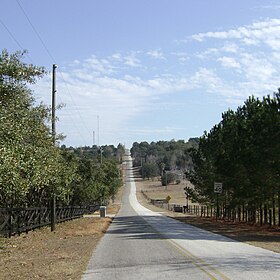Sugarloaf Mountain (Florida)
| Sugarloaf Mountain | |
|---|---|

Road leading to the summit of Sugarloaf Mountain
|
|
| Highest point | |
| Elevation | 312 ft (95 m) |
| Prominence | 245 ft (75 m) |
| Listing | Florida’s Highest Points |
| Coordinates | 28°38′58″N 81°43′59″W / 28.6494413°N 81.7331317°WCoordinates: 28°38′58″N 81°43′59″W / 28.6494413°N 81.7331317°W |
| Geography | |
|
Location in Florida
|
|
| Location |
Lake County, Florida, United States |
| Parent range | Lake Wales Ridge |
| Topo map | USGS Astatula |
| Geology | |
| Age of rock | ~2,000,000 years |
| Mountain type | uplifted coastline |
| Climbing | |
| Easiest route | Hike, Road |
Sugarloaf Mountain is the fifth-highest named point in the U.S. state of Florida. At 312 feet (95 meters) above sea level it is also the highest point on the geographic Florida Peninsula. The mountain is in Lake County, near the town of Clermont. Comparatively, Florida's highest point, Britton Hill, rises to 345 feet (105 m) above sea level in the Florida Panhandle. However, Sugarloaf Mountain is the most prominent point in the entire state.
Sugarloaf Mountain, located along the western shore of Lake Apopka in Lake County, Florida, is the northernmost named upland associated with the Lake Wales Ridge, a series of sand hills running south to Highlands County. The mountain, really a ridge with rolling dome-like peaks, rises abruptly from the surrounding flat terrain. Its prominence is thought to be 245 feet (75 m), with its highest peak having a local prominence of approximately 200 feet (61 m) relative to the surrounding ridge. Despite not being the highest point in Florida (which is Britton Hill near the Alabama border, the lowest high point of any U.S. state), Sugarloaf Mountain's summit is the most prominent peak in the state, and in a national ranking, is more prominent than the most prominent hills in both Louisiana and Delaware.
Prior to the 20th century, Sugarloaf Mountain was a wilderness dominated by sandhill and flatwood pine forests. By the 1920s, logging had stripped the mountain of its hardwood vegetation, permanently altering its native environment. Scrub began to grow on the mountain's slopes, in addition to grapes, which were planted mostly to the south of the mountain for a decade or so.
By the 1940s, grape farming had declined due to fungal diseases, and it was replaced by citrus farming. Citrus plantations flourished on the flanks of Sugarloaf Mountain, providing the basis for the local economy until the 1980s, when freezes began to systematically devastate local groves. As the citrus industry faded, property on the mountain was rezoned for residential development, with value seen in the mountain's panoramic views of the surrounding area. Other lands abutting the mountain, primarily along Lake Apopka, were preserved with the intention of restoring long absent ecologies. Only a few citrus plantations and vineyards managed to persist to the present day.
...
Wikipedia

